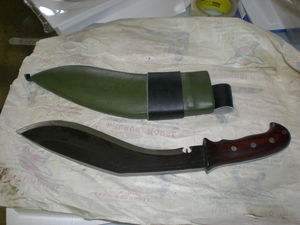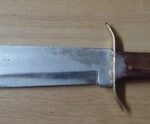I’m a big fan of knives and an even bigger fan of anything that’s custom made. So when my girlfriend opted to order a custom kukri from Nepal built to my specifications, I was more than thrilled. If you’re not familiar with the kukri (or khukuri), it’s a heavy-bladed knife from Nepal used frequently in farming. The single-edged blade is long and hefty and angles forward where it thickens. Unlike most knives that are balanced, the kukri carries most of its weight toward the end of the blade, making it an exceptionally effective chopping tool. Traditionally they are used for everything from clearing brush to chopping firewood to skinning animals. They are also the standard issue knife for the Gurkha military.
Now you see why I like them.
My knife was ordered from Khukuri House, the main manufacturer of kukris in Nepal. I looked over several designs from their catalog and decided on a mixture of two different models. The blade, a traditional outdoor use style, was from the AngPana For Jungle kukri, from their Survival Series. I selected that blade in particular because the style was designed for outdoor applications. A jungle knife would come in quite handy in the woods where I frequently backpack. I’ve found numerous uses for a large knife while adventuring, most nottably was when I severely twisted my ankle on a solo trip and had to cut down a small sappling to use as a makeshift crutch. I hiked for three more miles and made it safely back to the truck. Hoping that distance on one foot would have been impossible, but so would find a suitable walking stick without a knife with which to cut it to length.
The handle of the AngPana looked somewhat uncomfortable, but after browsing their selection, I found a more ergonomic grip in the SiruPate Special kukri. The handle was supposed to be made of horn, but due to unavailability at the time, I opted for Rosewood. The handle includes finger grooves and a hole in the end where one can affix a lanyard. On larger knives I always tie a loop of cord through the handle for safety reasons. When chopping, one can hold the knife with the loop around his wrist. If the knife somehow slips from your grasp, it will not go flying through the air.
I made a few adjustments to the measurements of the blade, adding a quarter of an inch to its width and almost an inch in length. I also took measurements of my hand and adjusted the handle to fit properly. With that done, the kukri was ordered.
The kukri arrived a few weeks later and I was amazed by the craftsmanship. The hefty blade, hand-forged from the leaf spring of a truck, was honed to a fine edge. The grip was deep burgandy in color and fit well in my grasp. The sheath, made from buffalo leather was dyed green. The overall appearance of the knife was not that of a store-bought blade. It was not shiny or decorative or pretty in any way. It was heavy, dull, sturdy and tough. This was a tool designed to function, not an ornament to be displayed.
My first test with the knife was to chop some small branches from a live tree. I struck the knife against a branch, using the belly of the curved blade to sever it at the base. The branch, nearly three inches in diameter, was detached from a single cut. I was impressed. I laid the branch across a board and proceeded to chop sections from it. Each section was sheard off with only one swing. The knife chopped like a hatchet. I made a few more chops on a wooden pallet, cutting off chunks of wood for fun.
Later that day I decided to sharpen the knife. I used a Lansky sharpening kit with progressive stones. The steel was quite hard but it took an edge rather well. Though the kit is designed to sharpen pocket knives and kitchen knives, I had little trouble sharpening the heavy blade of the kukri. When I was done, I could slice a sheet of paper in half without tearing, a feat only accomplished by knives sharp enough to slice tomatoes.
The second test I performed with the kukri was wood splitting. I used a piece of dried oak that was four inches wide, two inches thick and a foot long. Splitting it with a hatchet or ax would be easy, but I had never before split wood with a knife. I stood the piece of oak on a chopping block and took aim. I swung the kukri with one hand and brought the belly of the blade down on the end of the oak piece. The wood split with a crackle and the blade stuck into the chopping block. Quite an achievement for a knife.
I tried some delicate cutting and found that skinning a walking stick is quite easy when using the crook of the blade. I managed to peel off bark without damaging the wood of the stick. Making precise cuts is a bit more difficult as the blade is twelve inches long and front heavy.
I oiled the blade with machine oil to prevent rusting. It’s a hich carbon blade, not stainless, so you must use oil. However, the high carbon blade will hold an edge much longer than the softer stainless steel blades commonly found on the market.
All in all, the knife is quite beautiful in a rustic sort of way, extremely functional and built to last. With proper care, there’s no reason this knife shouldn’t outlive me.
I recommend kukris to anyone who might find the need for a utility knife, machette or hatchet. They’re wonderful tools that have proven their use for hundreds of years.






